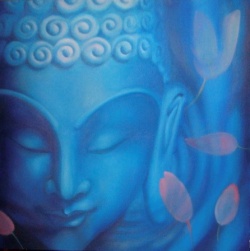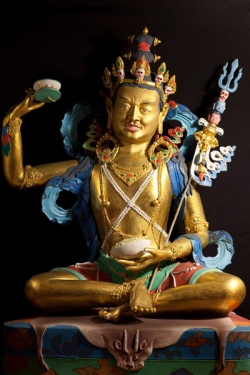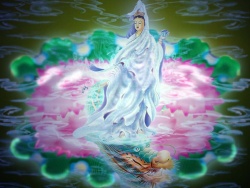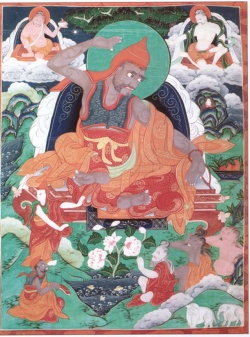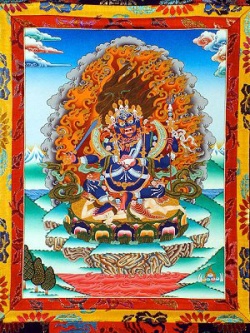Manual of Prajna Paramita - Reading Five: The Proofs for Emptiness
From the presentation on The Proofs for Emptiness ["The Emptiness of One or Many"] found in the Analysis of the Perfection of Wisdom, by Kedrup Tenpa Dargye (1493-1568):
Here secondly is our own position.
Consider the three: basic knowledge, path knowledge, and the knowledge of all things.
They do not really exist;
For they exist neither as one thing which really exists, nor as many things which really exist.
They are, for example, like the reflection of a figure in a mirror.
The Jewel of the Middle Way supports this when it says,
The things of self and other
Are free of being purely one
Or being purely many,
And so they have no nature:
Just like a reflection.
Consider these same things.
They do not exist as one thing which really exists;
For they are things with parts.
The one always implies the other, for if something existed as one thing which really exists, then it could never be a thing which appeared one way but actually existed in a different way.
They do not exist as many things which really exist, because they do not exist as one thing which really exists. The one always implies the other, for many things come from bringing together a group of things that are one.
The implication in the original statement is true, for if something really existed, it would have to exist either as one thing that really existed or as many things that really existed. This is always the case, for if something exists it must exist either as one or as many.
Here is the “Sliver of Diamond” reasoning, for denying that things can come from causes:
Consider all inner and outer things that perform a function. They do not arise ultimately, For they do not arise from themselves, and they do not arise ultimately from something other than themselves, and they do not arise from both, and they do not arise without a cause.
These things do not arise from themselves, because they do not arise from a cause which is such that, if something were the cause, it would have to be the thing it caused.
They do not arise ultimately from something which is other than themselves, for they neither arise ultimately from a cause which is other than themselves and which is unchanging, nor do they arise ultimately from a cause which is other from themselves and which is changing.
They do not arise ultimately from both the above, because they do not arise ultimately from either one of them individually.
They do not arise without a cause, because that would be utterly absurd. The implication in the original statement is true, for if something were to arise ultimately, it would have to arise ultimately through one of the four possibilities mentioned.
Here is the reasoning called “The Denial that Things which Exist or Do Not Exist could Arise,” which we use for denying that things can come from results:
Consider results. They do not arise ultimately, For results which exist at the time of their cause do not arise ultimately, and results that do not exist at the time of their cause do not arise ultimately, and results that both exist and do not exist at the time of their cause do not arise ultimately, and results that neither exist nor do not exist at the time of their cause do not arise ultimately.
The implication is proven in the same way as above.
Here is the reasoning known as “The Denial that Things could Arise through Any of the Four Possibilities,” which we use for denying that things can come from both causes and results:
Consider the functional things of causes and results. They do not arise ultimately, For multiple results of multiple causes do not arise ultimately, and single results of multiple causes do not arise ultimately, and multiple results of single causes do not arise ultimately, and single results of single causes do not arise ultimately.
[From the Overview:] Here we will explain the fifth type of reasoning, the one based on interdependence, and known as the “King of Reasons.” First we will present the reasoning, and then secondly prove the validity of its elements.
Consider all inner and outer things that perform a function.
They are not real, For they are interdependent. The reasoning can also be stated as:
Consider all inner and outer things that perform a function. They do not arise really, For they arise in dependence on other things which act as their causes and conditions.
Either way you state the reasoning, the following part should be added at the end: They are, for example, like the reflection of a figure in a mirror. This reasoning is correct, for it is spoken by the Protector (Nagarjuna):
Anything that occurs in interdependence
Is also peace in its very essence.
It is also proven by the Sutra Requested by Anavatapta, which states:
Anything that arises from other factors
Does not arise;
It has no nature of arising in this way.
I teach that anything which relies
On any other factor
Is empty.
He who understands emptiness
Acts rightly.
Now we will prove the various elements of this reasoning. This consists of two steps: proving the relationship between the subject and the reason, and proving the relationship between the reason and the characteristic asserted. Here is the first:
Consider all inner and outer things that perform a function. They are interdependent, For they consist of a label applied to their parts; they exist in dependence on their parts.
The relationship between the reason and the characteristic asserted is proved as follows:
If something either consists of a label applied to its parts, or exists in dependence on its parts, then it cannot be real;
For if something were real, neither of these two could apply to it.
This is true because, if something were real, it would have to exist without relying on anything else.
Proving the relationship between the subject and the reason in the latter version of the reasoning is simple. This is how we prove the relationship between the subject and the characteristic asserted in this same version:
If something arises in dependence on other things which act as its causes and conditions, it cannot arise really,
For if something were to arise really, it would have to arise without relying on anything else.
Both versions of the reasoning represent a type of logic where the presence of something which cannot coexist with something else is used to prove that inner and outer things which perform a function either do not exist really or do not have any nature of arising really. This is true because both of the reasons stated are such that they cannnot coexist with existing really.
There is a specific reason why we refer to this reasoning, the one based on interdependence, as the “King of Reasons.” First of all, each of the other reasonings here ultimately comes down to the reasoning of interdependence. Secondly, this reasoning allows one to eliminate, in one step, both the extreme of permanence and the extreme of ending focussed towards this particular subject or basis of dispute.
See also
- Manual of Prajna Paramita - Reading One: The Three Kinds of Refuge
- Manual of Prajna Paramita - Reading Two: The Wish for Enlightenment
- Manual of Prajna Paramita - Reading Three: What is Nirvana?
- Manual of Prajna Paramita - Reading Four: The Object We Deny
- Manual of Prajna Paramita - Reading Five: The Proofs for Emptiness
- Manual of Prajna Paramita - Reading Six: Who is Maitreya?
- Manual of Prajna Paramita - CLASS NOTES
